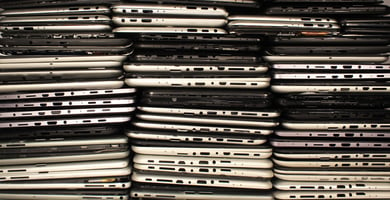Your Surplus Technology Isn’t Trash - It’s a Hidden Asset When organizations think about surplus IT...
ITAD: A Complete Guide on IT Asset Disposal
Picture this: your office storeroom is filled with aging laptops, outdated servers, and a mix of hard drives that haven't seen the light of day in years. As an IT professional, you know these assets have outlived their usefulness, but what should you do with them?
Enter ITAD – or IT Asset Disposition – a structured process for handling end-of-life IT equipment in a secure, environmentally friendly, and cost-effective manner. ITAD isn’t just about getting rid of old devices; it’s about doing so responsibly while ensuring sensitive data is protected and e-waste is minimized.
Why ITAD Matters
When it comes to decommissioning IT assets, you can’t simply toss them in the trash. ITAD is critical for organizations because it ensures complete data erasure and compliance with industry regulations and guidelines.
-
Security Concerns: Data breaches are a significant risk if IT assets aren’t disposed of correctly. Every hard drive, server, or laptop might still contain sensitive data, even if you think it’s been deleted. Without proper data sanitization, you could expose your company to serious security threats.
-
Environmental Impact: Did you know that e-waste accounts for millions of tons of waste every year? By following an ITAD process, you ensure that obsolete devices are recycled, refurbished, or disposed of in an eco-friendly manner, helping to reduce your carbon footprint.
-
Cost Efficiency and Asset Recovery: One of the lesser-known aspects of ITAD is its ability to recover value from old equipment. Rather than letting these assets collect dust, ITAD can help you recover some of their initial investment through resale, recycling, or even donation.
By incorporating IT asset disposition into your company’s IT strategy, you’re not just protecting your organization; you’re also contributing to a more sustainable future.
The ITAD Process
An ITAD process can look very simple or complicated depending on your organization’s needs and the IT assets you are looking at disposing of. And even the disposal part can look different for each company. The basic process of ITAD involves a plan, data destruction in some shape or form and then the disposal of that asset.
-
Inventory and Assessment: Before diving into IT asset disposal, create a detailed inventory of all IT assets slated for retirement. This includes identifying each device’s make, model, condition, and whether it holds any residual value. An accurate inventory is crucial for ensuring no devices are overlooked and every asset is accounted for.
-
Data Sanitization: Data security is the most critical step in ITAD. Even after deletion, data can be recovered if not properly wiped. Use certified data destruction methods such as data wiping, degaussing, or physical destruction to ensure all sensitive information is irretrievably erased. This step protects your company from potential data breaches or compliance issues.
-
Asset Valuation: Determine the value of your IT assets. Some may have resale potential, especially if they’re still in working condition. ITAD vendors can often assist with this, helping you identify assets that can be resold, refurbished, or donated. This is where you can recoup some of your investment.
-
Logistics and Transportation: Once the assets are sanitized and evaluated, it’s time to arrange for their transportation. Many ITAD vendors offer secure logistics services to ensure your equipment reaches its destination without risk of loss or damage. Always choose vendors with a strong reputation for safe handling. This step may take place before the data is wiped or destroyed. Some ITAD providers will come to your organization, pick up the assets and bring them to their facility for secure destruction. It all will depend on the provider, your preferences and the assets being disposed of.
-
Recycling and Disposal: Not all IT assets will have resale value, especially if they’re outdated or damaged. In these cases, proper recycling or disposal is necessary. Certified ITAD vendors follow strict guidelines to recycle components responsibly, ensuring they don't end up in landfills. This step is crucial for environmentally friendly IT asset disposal.
Following this structured process ensures that your company’s IT asset disposition is thorough, secure, and environmentally responsible.
Best Practices for Effective ITAD
To make your ITAD process efficient and secure, follow these best practices:
-
Plan Ahead: Establish a clear ITAD policy within your organization. This ensures all stakeholders know the steps involved, timelines, and responsibilities, making the entire IT asset disposition process smoother.
-
Choose a Certified ITAD Vendor: Not all ITAD vendors are created equal. Look for certifications such as R2 (Responsible Recycling) or NAID AAA, which show that the vendor follows industry best practices for data security and environmental responsibility.
-
Prioritize Data Security: Data breaches can be disastrous. Always ensure data sanitization is performed before any asset leaves your premises. Never assume that deleted data is gone; use professional data wiping or destruction services.
-
Track and Document Everything: Keep thorough records of every step in the ITAD process. This includes inventories, data sanitization reports, transportation details, and final disposition certificates. You will always want to walk away with a Certificate of Destruction. This documentation is crucial for compliance audits and provides peace of mind knowing that your IT assets were handled correctly.
Implementing these best practices will help streamline your IT asset disposal process and minimize risks.
Benefits of Implementing ITAD
If you're still on the fence about embracing ITAD, consider these advantages:
-
Maximized ROI: ITAD allows you to recover value from your retired IT assets, whether through resale, refurbishment, or recycling. This offsets the cost of new equipment and helps make your IT budget go further.
-
Reduced Risk: Proper IT asset disposition ensures that data is securely wiped, protecting your organization from potential breaches, fines, or legal actions.
-
Environmental Responsibility: By recycling and disposing of IT assets responsibly, your organization contributes to reducing e-waste and conserving valuable resources. This not only benefits the environment but also enhances your company's reputation as a responsible corporate citizen.
Why Choose Synetic for Your ITAD Needs?
Synetic Technologies stands out as the best choice for an ITAD provider because of our comprehensive, security-first approach tailored to protect data, ensure compliance, and promote sustainability. We’re certified in the latest data destruction standards and specialize in meeting strict healthcare regulations, including HIPAA and GDPR, providing clients with complete peace of mind. Our end-to-end services cover everything from asset tracking and secure data wiping to certified recycling and resale, reducing environmental impact while maximizing asset value. With Synetic, you’re not only choosing a provider—you’re choosing a partner committed to seamless, secure IT asset management at every stage.
In the world of IT, managing outdated assets is a challenge every professional faces. By embracing ITAD, you’re not just disposing of old equipment – you’re protecting sensitive data, contributing to a sustainable future, and potentially recouping valuable resources. Start implementing a structured IT asset disposition process today, and experience the peace of mind that comes with responsible IT asset disposal.
-min.jpg?width=50&name=Todd%20Leach%20(Default%20-%20Output%202)-min.jpg)


.jpg?height=200&name=DSC00522%20(1).jpg)